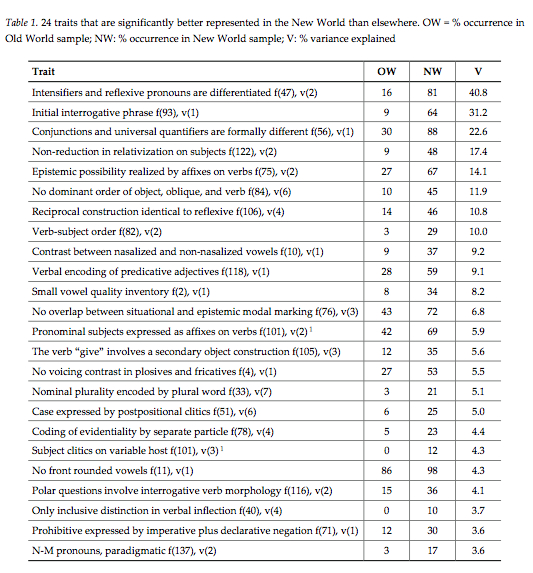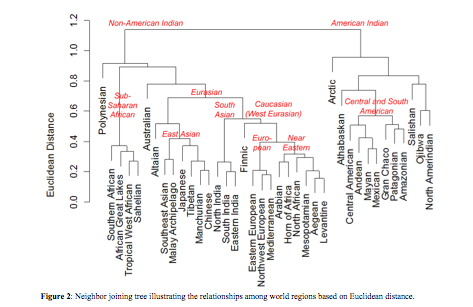American Indian Uniqueness: Linguistics and Genetics
Journal of Linguistic Relationship 5 (2011): 130-134.
Similarities among Languages of the Americas: An Exploration of the WALS Evidence
Wichmann, Søren, Eric W. Holman, Dietrich Stauffer, and Cecil H. Brown.
Abstract. An exploration of WALS (i.e. the World Atlas of Language Structures, edited by Haspelmath et al., 2005) has brought out a number of linguistic features that are significantly better represented in the New World than anywhere else. 24 such features remain when features that are restricted to certain subareas of the Americas are excluded. Two possible explanations are consistent with the available data. The features in question may be inherited from some language ancestral to all or most of the languages of the Americas. Alternatively, the features may be diffused across distances much greater than typically encountered in language areas. More data will be necessary to decide between these explanations.
Link (Free Full Text PDF)
An international team of linguistics led by Søren Wichmann, of Max Planck Institute for Evolutionary Anthropology, published a list of grammatical, morphological and phonological features that have significantly higher frequencies in American Indian languages over Old World languages. They mined The World Atlas of Linguistic Structures (WALS), which is the premier source of global linguistic variation. This said, WALS has uneven coverage of world languages and only 100 languages have been screened for all features. Data insufficiency makes the results of this study preliminary but even the current low coverage database shows a clear pattern that’s consistent with the patterns of American Indian specificity that emerge from more complete data sets such as those of population genetics and kinship studies. Wichmann et al. isolated 24 linguistic traits (see below) that are more or less uniformly distributed across all the regions of the New World. This means that the areal features that are unique to the Americas did not make the list.
 Wichmann et al. established that the probability that the American Indian languages stand out because of pure chance is only 0.0001. Having virtually excluded the possibility that American Indian linguistic uniqueness is purely accidental, they proceeded to identify two hypotheses that could plausibly explain the pattern.
Wichmann et al. established that the probability that the American Indian languages stand out because of pure chance is only 0.0001. Having virtually excluded the possibility that American Indian linguistic uniqueness is purely accidental, they proceeded to identify two hypotheses that could plausibly explain the pattern.
One is the idea that American Indian languages developed from a small number of structurally uniform languages (or from one single language) that had time to develop unique features because of a prolonged period of isolation spent by the New World founding population somewhere in Beringia. Wichmann et al. borrowed this hypothesis from population genetics, where it has gained mainstream traction over an alternative theory that modern American Indian populations formed as a result of multiple migrations to the New World. For instance, the 9 repeat allele (9-RA) is an autosomal marker pervasive in American Indian populations. 91% of chromosomes that exhibit the 9RA are flanked by an identical genetic background that spans some 76.26 kilobases, a haplotype that Schroeder et al. (“Haplotypic Background of a Private Allele at High Frequency in the Americas,” Mol Biol Evol 26, 2009) called the “American Model Haplotype.” In a study of the distribution of blood group ABO alleles in contemporary American Indian populations from Mesoamerica and South America, Estrada-Mena et al. (“Blood Group O Alleles in Native Americans: Implications in the Peopling of the Americas,” American Journal of Physical Anthropology 142, 2010) found a O allele, called O1v(G542A) in every American Indian population screened to date at the sequence level. These genetic patterns are analogous to the ones Wichmann et al. describe linguistically.
Most commonly, the multiple-migration model is associated with the three-wave theory advanced by Greenberg, Turner and Zegura in 1986 on the basis of linguistic, odontological and genetic evidence. Since 1986, geneticists have moved, almost unanimously and across all genetic systems, toward a single-migration scenario to explain modern American Indian genetic variation. Now, Wichmann et al. are advancing evidence that may move linguistics into the same direction – away from the deeply-flawed classification of American Indian languages by Joseph Greenberg and Merritt Ruhlen into Amerind, Na-Dene and Eskimo-Aleut stocks toward a perspective that sees all American Indian families as ultimately related to each other. This evidence comes not from the traditional comparative method – it’s not a 100-word Swadesh list connected by multiple sound correspondences, but relative frequencies of grammatical, morphological and phonological traits that set American Indian languages apart from the languages of the Old World. The N-M pronoun pattern is the only exception: it’s a controversial phonomorphological pattern that’s found all over the Americas (plus in a couple of languages of Papua New Guinea). Greenberg and Ruhlen, who popularized the N-M pronoun pattern, claimed that it’s a defining feature of their Amerind grouping. Wichmann et al. elevated it to the status of a pan-American feature because Amerind is a pan-American grouping.
Wichmann et al.’s other hypothesis to explain the pervasive presence of 24 linguistic traits is diffusion. According to this model, the founding American Indian population(s) were linguistically heterogeneous but, since the peopling of the America event, forces of diffusion re-distributed the 24 traits evenly across the continent. This model harkens back to R. M. W. Dixon’s theory formulated in The Rise and Fall of Languages (Cambridge, 1997) whereby languages evolve by spurts of fast differentiation followed by prolonged periods of diffusion that reduce their original diversity.
What is missing from Wichmann et al. is the hypothesis regarding the time required for the 24 unique linguistic traits to form in an isolated parent population or for them to get evenly distributed across a vast continent. In Dixon’s theory – arguably speculative, – the reduction of linguistic diversity takes a long time, longer than the time required for linguistic differentiation. When he applied his hypothesis to American Indian languages, he quickly arrived at a recent timing for the peopling of the Americas because, in his theory, the number of linguistic stocks (140 in the case of the Americas) found on a continent is inversely proportionate to the time elapsed since the peopling of the continent. This is because Dixon assumed that America was peopled as a result of rapid colonization over a wide geographic terrain, not following a long period of isolation in a geographically secluded area such as Beringia. If, on the contrary, it’s isolation that’s invoked to explain linguistic differentiation, then there’s no reason to assume that this differentiation occurred at a fast pace.
The combined strength of the 24-trait uniqueness and the 140-stock diversity factors found in the New World languages imply great antiquity. In fact, Wichmann et al. may give us a clue as to the relative chronology of the emergence of American Indian linguistic specificity. Their analysis shows that American Indians are contrasted on 24 grammatical, morphological and phonological traits with the languages of the Old World. Not with the languages of Siberia or East Asia, but with the languages of the Old World as a whole. If American Indians were an offshoot of an East Asian population, we would have seen a pronounced frequency pattern differentiating them from East Asians and East Asians only. Apparently, the data says otherwise: American Indians are old enough to be opposed to the totality of Old World languages. The inference of great antiquity of American Indian languages neutralizes the very analytical distinction between isolation and diffusion, as great antiquity implies that American Indians were isolated from Old World populations for such a long time as to enable vast sharing of linguistic features across the vast swaths of the New World. It also eliminates the need for such artificial and non-parsimonious idea as “Beringian incubation.” If a Beringian refugium indeed existed, we would’ve observed elevated frequencies of those 24 features in the Northeast corner of Siberia and on the Northwest Coast of America. Apparently, this is not the case. Instead, the whole of the New World, in accordance with the pattern of geographic distribution of the 24 traits, is the “incubator.” This is consistent with the fact that it’s the whole of New World that harbors the 140 language stocks, not the area around Beringia.
While geneticists tend to construct phylogenetic trees that make American Indian populations look like populations recently derived from Asia, one tree of autosomal markers published by one of the personal genomics companies, DNA Tribes (see below), depicts the New World-Old World split as the primary split in the global phylogeny.
 This tree seems to fit linguistic data presented by Wichmann et al. very well. (“Polynesia” on this tree likely refers to the “Papuan,” not the “Mongoloid” component in Polynesians.) Under this model, one would naturally expect American Indian languages to be different from Old World languages on 24 grammatical, morphological and phonological traits. This model is also perfectly consistent with either Out-of-America I or Out-of-America II theories of human origins and dispersals. Noteworthy, Schroeder et al. reported that, outside of America and Western Beringia, the “American Modal Haplotype” is found in South Asia (12.63%), Europe (9.54%) and Middle East (9.47%). Despite its geographic proximity to the New World, in Siberia, outside of Western Beringia, the “American Modal Haplotype” is less frequent (5.79%). It’s found in one Mandenka individual in Africa and is not found in Oceania. This distribution is in good fit with the distribution of the “Amerindian component” recently detected by genome bloggers.
This tree seems to fit linguistic data presented by Wichmann et al. very well. (“Polynesia” on this tree likely refers to the “Papuan,” not the “Mongoloid” component in Polynesians.) Under this model, one would naturally expect American Indian languages to be different from Old World languages on 24 grammatical, morphological and phonological traits. This model is also perfectly consistent with either Out-of-America I or Out-of-America II theories of human origins and dispersals. Noteworthy, Schroeder et al. reported that, outside of America and Western Beringia, the “American Modal Haplotype” is found in South Asia (12.63%), Europe (9.54%) and Middle East (9.47%). Despite its geographic proximity to the New World, in Siberia, outside of Western Beringia, the “American Modal Haplotype” is less frequent (5.79%). It’s found in one Mandenka individual in Africa and is not found in Oceania. This distribution is in good fit with the distribution of the “Amerindian component” recently detected by genome bloggers.
Now, the question is: is the presence of the American Modal haplotype in Western Beringia a sign of a Boasian back-migration (see Out of-America III, IV) from America at the end of the recent Ice Age or it’s a retention from the founding migration out of the Americas that led to the spread of modern humans in the Old World?

